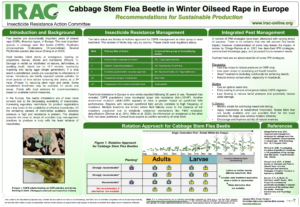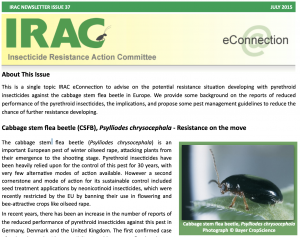Cabbage stem flea beetle
Psylliodes chrysocephalaThe cabbage stem flea beetle (CSFB) Psylliodes chrysocephala (Coleoptera: Chrysomelidae) is a serious pest in winter oilseed rape with variation in abundance and damage between years. It has high importance in Europe, but problematic also in Canada and Russia.
The adult beetles invade fields at the time of crop emergence and can cause serious damage by feeding on cotyledons, leaves, shoots and meristems. The larvae are mining the petioles and later stems from the autumn to the following spring. The plants attacked by the larvae become bushy and stunted. In the case of high pest pressure both stages can destroy the crop.
The CSFBs are univoltine and stay in the oilseed rape field most of their cycle. They have two main periods of displacement before summer diapause is to avoid unfavourably high midsummer. The displacement before summer diapause is to avoid unfavourably high temperatures. The beetles move from the fields into cooler and shadier places of higher relative humidity in field margins and hedgerows.
Their flight ability is good, can fly even longer distances. After field invasion, their behaviour gradually changes from movement by flight to jumping.
Forecasting is widely based on monitoring the activity density of adult beetles with yellow water traps in the main period of field invasion. There is not always direct correlation between trap catches and subsequent larval density since temperature and soil humidity influences the number of eggs laid as well as the number of eggs hatching in the autumn.
The young adult appears in April/June, the female starts to lay eggs in autumn, stops when the temperature falls and start again at the end of the winter, in total they lay up to 150 eggs. The larvae appear from autumn and overwinter as either first, second or third instars dependent on the start of egg-laying and temperature. In mild winters, adults also can overwinter. The CSFB is adapted to temperate regions with moderately cold winter conditions and can withstand sub-zero temperatures during winter.
Integrated Pest Management
In some European countries, regulatory hurdles limited farmers’ toolbox to have only 1 or 2 mode of action insecticides available/registered against CSFP, which resulted fast evolvement of pyrethroid resistance. As the insecticide treatments are sometimes not efficient, an IPM approach is needed to successfully manage the pest. It seems currently there is no any single method, which can manage the CSFB pest problem. Some practical IPM strategies are the use of optimal seed rate at a late or early sowing time; using trap and cover crops, natural enemy conservation, lengthening rotations, leaving post-harvest volunteers in fields, but these actions have limited effect on crop protection and cannot manage high pest pressure situations. Monitoring the adult flights for optimizing insecticide timing at established thresholds and rotating MoAs that are locally available and use them at the most sensitive life stage are essential to be successful.
Cabbage stem flea beetle resistance profile
Pyrethroid resistance in Europe is now widely spread following 30 years of use. CSFB populations have developed both target site and metabolic resistance.
Bifenthrin, lambda-cyhalothrin, etofenprox and tau-fluvinate resistance cases are reported in the MSU arthropod pesticide resistance database. In many EU countries only pyrethroids are registered against the pest, which increase the threat of resistance development.
| Species | Distribution | Chemical class | Mechanisms |
|---|---|---|---|
| Psylliodes chrysocephala | Europe | Pyrethroids-Pyrethrins (3A) | Target site resistance (kdr-L1014F; skdr-L925I) Metabolic resistance (P450 mediated-detoxification) |

